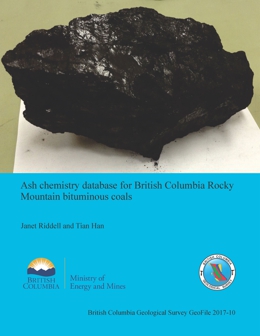| Publication Summary
|
| Issue ID: | GF2017-10 |
| Title: | Ash chemistry database for British Columbia Rocky Mountain bituminous coals |
| Author(s): | Riddell, Janet and Han, Tian |
| Series Name: | Geofile |
| Publication Year: | 2017 |
| NTS Map Sheet(s): | 082G,J,K,N; 093I,O,P; 094B |
| Place Keyword(s): | British Columbia, Rocky Mountains |
| Lat/Long (NSWE): | 56.5, 49, -124, -114 |
| Theme Keyword(s): | Coal ash geochemistry database, bituminous coal, coking coal quality, Gates Formation, Gething Formation |
| Download(s): | PDF, ZIP (View Zip Contents) |
Abstract:  | Ash is the inorganic residue remaining after coal combusts. It is composed of oxides of the mineral content in the coal. Coal ash chemistry can have a significant influence on coke strength after reaction (CSR), an important measure of coking coal quality. Coals that were overlain by non-marine deposits (which includes most Canadian Rocky Mountain coals) generally have mineral assemblages that form ashes with low ratios of reactive oxides (i.e. Fe2O3, CaO, MgO, Na2O and K2O) to refractory oxides (i.e. SiO2, Al2O3 and TiO2), which favours good coke strength under blast furnace conditions. Coal ash chemistry is also used to predict slagging and fouling potential in the furnaces or kilns of all types of coals. This database compiles ash chemistry analyses of British Columbia Rocky Mountain bituminous coals from public sources into a standardized relational format to facilitate its distribution and use. |





